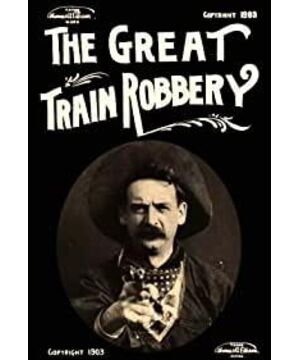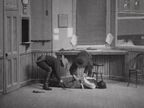The movie "The Train Robbery", released in 1903, was the most popular movie at the time. It has been in theaters in the United States for ten years.
The film is adapted from real events that took place in the United States in 1900, and the location of the film was set in New Jersey, the United States.
"The Train Robbery" is the first western film, the first police and criminal film, and the first crime film in film history.
After this film, film technology such as location shooting, camera movement, continuity editing, and special effects gradually matured.
For such an important movie, director Edward Porter only used 14 scenes, and finished the story wonderfully without subtitles.
In the first scene of the film, two robbers entered the train station studio with guns, threatened employees to signal the train, then knocked them to the ground, tied them up, and left. The detail is that the robbers actually remembered to use a cloth to block the mouths of the employees, which shows how careful the director is.
It is worth noting that the moving train can be seen through the windows of the studio, and mask photography is used here.
In the second scene, the train was resupplying at the water tower, and the four robbers slipped onto the train without being prepared.
In the third scene, two robbers broke into the luggage compartment, and the train staff inside locked the box and threw the key off the train. The two sides started a gun battle, and the train employees were unfortunately killed. The robber blasted the box and took away the belongings. And outside the door of the open train is a flash of trees (masked photography). Smoke effects are used for shooting and explosions.
In the fourth scene, two other robbers approached and tried to control the front of the car. After a fight, the robbers killed a train employee and threatened another employee to stop the train. In this scene, the actor enters the shot from close to the bottom of the camera, and then away from the camera. In previous movies, most of the actors' telemotion in front of the camera was the same as in a stage play, moving from the left to the right of the camera, or from the right to the left.
In the fifth scene, the robbers asked the living staff to separate the front of the car from the back car.
In the sixth scene, the robbers forced the passengers to get out of the car and began to rob the passengers of their belongings. When a male passenger tried to escape, he was shot by a robber and fell to the ground. The robbers ran to the front of the car after looting the property. The passengers hurried to see the passenger who was shot.
In this scene, the performance of the male passenger wearing a light-colored plaid coat among the passengers is impressive. After being driven out of the car, he was always paying attention to the surroundings, as if he might escape at any time. Because of his sore arm, he kept secretly lowering his arm, and when the robber's gun swept across in front of him, he quickly stretched it out. Because of the rough picture, we can't see the actor's expression clearly, but his fear is revealed.
It should be noted that in this scene, the robbers ran out of the camera from left to right, while in the next scene, the robbers entered the lens from the right side of the camera and ran to the left. This should be a mistake by the director. The correct approach is to keep the actors moving in the same direction in the two scenes before and after, so that the whole movement has continuity. In this way, the connection between the two scenes will not appear abrupt, nor will it cause confusion to the audience.
In the seventh scene, the robbers drove the front of the car and fled.
In the eighth scene, the robbers abandoned the front of the car and ran towards the valley. (There is a moving camera at this time, and the camera moves with the direction of the actor's movement.)
In the ninth scene, the robbers went deep into the valley and ran towards the camera. Then they crossed the stream and moved to the left. The camera then moved to the left, and the horse prepared before appeared. The robber mounted his horse and continued to flee.
In this scene, the actors approach the camera from a position far away from the camera. With the movement of the lens, the prepared horse enters the lens from the left side of the lens, bringing surprises to the audience.
In the tenth scene, I returned to the train station studio in the first scene. The employee who had been tied to the ground struggled to stand up and then fell to the ground. At this time, a little girl came in and rescued him.
In the eleventh scene, local residents and police are dancing happily indoors, and train station employees come to ask for help.
In the twelfth scene, on the forest path, people caught up with four robbers. During the horse-riding pursuit, a gun battle started and a robber was shot and killed.
In the thirteenth scene, the remaining three robbers dismounted in the forest and began to divide the spoils. At this moment, people chased up, and after the gun battle, the remaining three robbers also fell under the gun. After inspecting the body, people recovered their belongings.
The fourteenth scene, a close-up shot: a western cowboy raises a revolver, faces the camera, and shoots at the audience. When the film was first released, this shot was placed at the beginning of the film.
This shot, at the time, can be said to be a shocking, breaking the fourth wall for the first time in the history of film. Since then, countless latecomers have been keen on this approach, and the movie "Deadpool" is widely known recently.
View more about The Great Train Robbery reviews







